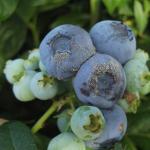Blueberry IPM - Botrytis Blight/Gray Mold
Blueberry – Botrytis Blight/Gray Mold (Botrytis cinerea and B. pseudocinerea)
ID/Disease Cycle: Rotted flowers and berries are typically covered with a gray fuzz of mycelium and spores, which gives the disease its name. Infection occurs during bloom on flowers and tender green tissue. Moderate temperatures (60˚F – 68˚F) and frequent rain favor disease development.
Botrytis cinerea and B. pseudocinerea are similar in many ways and both have been identified on blueberries in North America. Both species have wide host ranges that include numerous crops and wild plants. The fungi survive the winter on dead twigs and crops debris. They also form sclerotia, which can persist in soil for many years. . The fungi are present every year, but only cause severe damage during cool, wet periods several days in duration. In spring, they produce abundant spores that are carried on the wind to susceptible plant tissues. Very young plant parts are especially vulnerable to infection. The most critical period for infection of blueberry is during bloom. The optimum temperature range for spore germination is 20-25°C (68-77°F), while the optimum for infection is 16-20°C (61-68°F). Infections often progress from flower clusters into the main stem, causing twig blight.
Damage: Damage is to fruit production, quality and storage life.


Management:
Monitoring: Consult scouting records from previous years to determine if build-up of this disease is indicated. Monitor weather conditions to identify likely infection periods. Scout fields beginning at bloom for symptomatic tissue. Some cultivars have shown resistance or higher tolerance for this disease – these include ‘Elliott’ and ‘Bluecrop’.
Control strategies:
Cultural/Biological:
- Prune bushes to open the canopy to light, air, and spray penetration.
- Avoid overhead irrigation that wets plant surfaces.
- Avoid excessive nitrogen fertilization that can result in a dense canopy.
- Harvest frequently to limit the amount of overripe fruit present in the field.
- Refrigerate harvested fruit as soon as possible.
Chemical:
- See New England Small Fruit Management Guide for currently recommended spray materials for Botrytis in Blueberries.
- Apply recommended fungicides beginning at mid-bloom if scouting and weather monitoring indicate risk of infection.
- Repeat fungicide applications at recommended intervals if weather conditions are conducive to infection.
- Rotate fungicide materials from different FRAC groups to avoid promoting the development of resistant strains of this disease.
Date: February 2020
Author(s): Angela Madeiras and Sonia Schloemann, UMass Extension
Visit our website: http://ag.umass.edu/fruit
Additional information available on the MYIPM app: https://apps.bugwood.org/apps/myipmseries/
Note: This information is for educational purposes only and is reviewed regularly for accuracy. References to commercial products or trade names are for the reader’s information. No endorsement is implied, nor is discrimination intended against similar products. For pesticide products please consult product labels for rates, application instructions and safety precautions. The label is the law. Users of these products assume all associated risks.
This work was supported in part by funding provided by USDA NIFA Extension Implementation Program, Award No. 2017-70006-27137